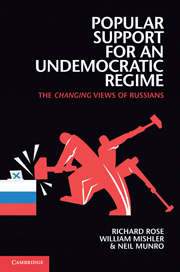Book contents
- Frontmatter
- Contents
- List of figures
- List of tables
- Introduction: The need for popular support
- 1 Democratic and undemocratic models of support
- 2 Changing the supply of regimes
- 3 Putin consolidates a new regime
- 4 Increasing support for an undemocratic regime
- 5 Individual influences on regime support
- 6 Time tells: there is no alternative
- 7 Finessing the challenge of succession
- 8 The challenge of economic reversal
- 9 Maintaining a regime – democratic or otherwise
- Appendix A New Russia Barometer samples
- Appendix B Coding of variables
- References
- Index
4 - Increasing support for an undemocratic regime
Published online by Cambridge University Press: 05 June 2012
- Frontmatter
- Contents
- List of figures
- List of tables
- Introduction: The need for popular support
- 1 Democratic and undemocratic models of support
- 2 Changing the supply of regimes
- 3 Putin consolidates a new regime
- 4 Increasing support for an undemocratic regime
- 5 Individual influences on regime support
- 6 Time tells: there is no alternative
- 7 Finessing the challenge of succession
- 8 The challenge of economic reversal
- 9 Maintaining a regime – democratic or otherwise
- Appendix A New Russia Barometer samples
- Appendix B Coding of variables
- References
- Index
Summary
To describe regime change as a political transition is correct but vague; it raises the critical question: In what direction is the regime heading? The simultaneous collapse of undemocratic regimes stimulated a vast literature about change in a single direction, democratization. Samuel P. Huntington (1991) proclaimed a third wave of democracy and Francis Fukuyama (1992), invoking a Hegelian metaphor, described the collapse of the Communist system as “the end of history.” Many quantitative ratings of regime change make democracy their end point (e.g. Vanhanen, 2003; Przeworski et al., 2000). Countries at the other end of the scale are simply treated as “not democracies,” when in fact they may be successfully consolidating undemocratic regimes.
In a totalitarian regime change can go in only one direction: a reduction in the intrusive claims of the state over the lives of its subjects. The abandonment of totalitarian aspirations does not imply a commitment to democratization. Changes within the Soviet Union and its satellites simply made Communist regimes govern in a post-totalitarian manner through institutions that had been created in pursuit of totalitarian goals. Post-Communist transformation was something very different: It involved the simultaneous alteration of the economy and of society as well as the political regime, and the creation of more than a dozen new states (Rose, 2009c). The maelstrom of transformation gave confusing signals about the direction of change. Political and economic imperatives led to reversals in direction and rhetoric in a trial-and-error search for support.
- Type
- Chapter
- Information
- Popular Support for an Undemocratic RegimeThe Changing Views of Russians, pp. 64 - 83Publisher: Cambridge University PressPrint publication year: 2011

